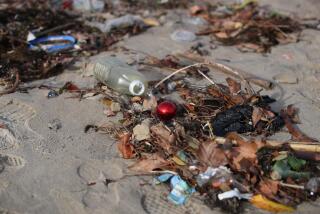The Ooze and Ahs of Science
- Share via
Philip Young eats crickets, scorpions and locusts. The 10-year-old grows mold in honor of his hero, Louis Pasteur. And the bespectacled budding scientist sometimes picks blisters to examine what comes out.
“I already know some stuff about mucus,” Young said, “but there’s so much more to learn. I want to become an expert.”
The more gross the information, the more interesting it is to Philip and many children his age. Teachers, librarians and museum curators are hoping to translate bathroom humor into scientific curiosity by offering lessons in “grossology” -- the science of indelicate things.
The Discovery Science Center in Santa Ana this holiday weekend is resurrecting “Gross Me Out!,” a stage show that teaches children about “the grossest thing in the world -- our bodies,” said Lisa Segrist, a center spokeswoman. The performance -- one of its most popular since the center opened in 1998 -- features host “Sally Snot,” who quizzes guests on the causes of flatulence, vomit and the color of urine.
“The kids love it,” she said, “especially the little ones.”
Last weekend, more than 1,200 people attended the show, which ends Monday, boosting the center’s attendance by 25%.
Such enthusiasm pleases Sylvia Carol Branzei-Velasquez, the world expert on armpit odors, ear wax genealogy and bathroom byproducts. The 45-year-old former science teacher lives by these words: “Sometimes it’s stinky. Sometimes it’s crusty. Sometimes it’s slimy. But hey, it’s your body.”
Let’s be honest -- most children, teenagers and some adults giggle, chortle and snort at the mention of inelegant body functions. Hollywood knows a joke involving bodily functions is money in the bank. However, grossology in the classroom “has nothing to do with being gross,” Branzei-Velasquez said by telephone from her home in Point Roberts, Wash. “It’s a hook to draw them into science and reading.”
Originally, the trademarked term referred to the lesson plans -- and books and museum exhibits -- developed by Branzei-Velasquez starting in 1993.
However, as the subject became more popular, the definition of grossology has expanded, teachers and librarians say. It can include popular children’s books that feature a piece of excrement as a main character, as well as teaching materials that depict gory, cataclysmic events to illustrate physical and biological sciences.
Some educators call grossology a gimmick -- one with the potential to engage students, but little else.
Philip’s mother, Jane Young, encourages his passion for the gross. She buys him edible bugs and helped him enter one of his mold creations into the fourth-grade science fair, which he won. She draws the line at popping blisters and picking scabs.
When she heard that the San Marino Public Library offered an after-school lecture centered on blood, blisters and mucus, she immediately thought of Philip. “He couldn’t wait to learn all about it,” his mother said.
That’s exactly what Tara Smith likes to hear. “We’re competing for their attention,” said Smith, children’s librarian at the San Marino library, which sponsored the grossology event this month. “This definitely got the kids interested.”
The activity reigned as one of the library’s most popular to date. Smith heard about grossology from an Internet discussion group for children’s librarians. “They all talked about how successful it was,” she said. “Judging from the response we’ve had, we’re more than likely to do it again.”
Branzei-Velasquez conceived of grossology more than a decade ago while living in Northern California. She was intrigued by the crud in her toenails. While clipping, she had an epiphany: “I thought, ‘Whoa. Kids really like gross stuff, and I really, really want to teach them science.’ ”
Then she tested it on her students, mostly between the ages of 7 and 12. They couldn’t get enough, she said. The success spurred her to write five books on grossology, found in schools, libraries and kids’ rooms nationwide.
The books led to speaking engagements and traveling museum exhibits featuring interactive displays, such as “Y U Stink,” which releases faux smells of bad breath, flatulence, stinky feet and deodorant-free underarms.
She also runs a website, www.grossology.org, which allows visitors to vote on their favorite gross topic. The vote is ongoing, but as of mid-May, diarrhea ranked No. 1, narrowly edging out flatulence and poop. (Body odor, gingivitis and warts rated as the least favorites.)
Branzei-Velasquez acknowledged that learning impolite facts won’t directly send students to college. She designed her materials as a supplement to standard science courses, or as after-school activities.
“A lot of grossology facts are trivial,” said Branzei-Velasquez, who has a bachelor’s degree in microbiology and a master’s in science education. “Seventy percent of what kids remember is how they felt about something, not a fact that nobody cares about. I want to get them feeling good about science.”
No studies exist showing whether grossology works. Academics who study disgust, however, said its taboo nature generally works at piquing people’s interest.
“There is a thrill value,” said Clark McCauley, a psychology professor at Bryn Mawr College. “It’s like riding a roller coaster or skydiving.... But the question is, how long does it hold one’s attention?”


